 loading
loading
featuresThe founder of modern ecologyAt five, G. Evelyn Hutchinson collected water mites. At Yale, his research on freshwater species reshaped scientific thinking about natural history. This article is excerpted from House of Lost Worlds: Dinosaurs, Dynasties, and the Story of Life on Earth (Yale University Press, spring 2016), by Richard Conniff ’73. 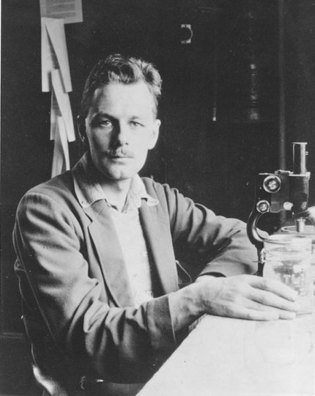 Manuscripts and ArchivesYale professor G. Evelyn Hutchinson (1903–1991)—shown in his early days at Yale, circa 1929—was a lifelong devotee of water bugs and a profoundly influential theoretical ecologist. View full imageIn 1928, a young Cambridge University graduate with no doctoral degree, who had failed in his first real experimental research at the Stazione Zoologica in Naples and been fired from his first job as a lecturer at South Africa’s University of Witwatersrand, arrived sight unseen for a temporary teaching position at Yale. There was little to indicate that he would remain beyond a brief fellowship, much less for the next 62 years (counting his continued work in retirement). Nor was there any reason to suspect he would become, in biologist E. O. Wilson’s words, the “founder” of modern ecology. G. Evelyn Hutchinson had effectively chosen his profession by the age of five, when he was already collecting sticklebacks, water spiders, and water mites to keep in small aquariums. His parents—a mother who was “a strong but strictly nonmilitant feminist” and a father who taught mineralogy at Cambridge—indulged his interest in all things aquatic. Up to a point: they presumably drew the line when, as a child, he pushed a friend into a stream at the University Botanic Garden. Later, he liked to say he did it “to see if she would float, an early interest in the hydromechanics of organisms of which I am not proud.” In the same spirit of experimentation, he and his younger brother once shut off the lights and locked their parents—and their parents’ guests, Sir George and Lady Darwin—in the dining room during a dinner party. (His biographer Nancy G. Slack notes that no information on the outcome of this experiment survives.) Hutchinson went on to a preparatory school with a reputation for science; there, at age 15, he published his first paper, about a swimming grasshopper, followed by another at 16 about a rare species of water strider (a type of insect, also called the Jesus bug, that skims across the water surface). Though he intended to study zoology, he took his entrance exams at Cambridge in mathematics, physics, and chemistry. He would combine zoology with these disciplines, hitherto largely foreign to natural history, for the rest of his career. It was the key to all his future discoveries. The failure in his research at Naples was largely a result of being unable to obtain enough specimens of his study animal, an octopus, and perhaps also of the misguided decision to undertake a marine project: he was by nature a freshwater biologist. He was likewise unsuited to his task during a two-year contract as a lecturer at the University of Witwatersrand. The professor to whom he was assigned was accustomed to having his lecturers function in the medieval manner—as readers of lectures he had written. Hutchinson apparently viewed the job differently, with the result that he was soon dismissed from teaching. He spent the remaining time on his contract studying South African birds and other wildlife, and especially on increasing his knowledge of water bugs. Collecting in the lakes and streams, he began to notice the conditions in which different species seemed to thrive, and he also puzzled over why some aquatic habitats fostered a great diversity of species and others not so many. Niche theory and the diversity question would become major elements in his thinking about ecology—that is, ecology in its proper scientific sense, meaning the study of how the organisms and physical conditions of a habitat interact. 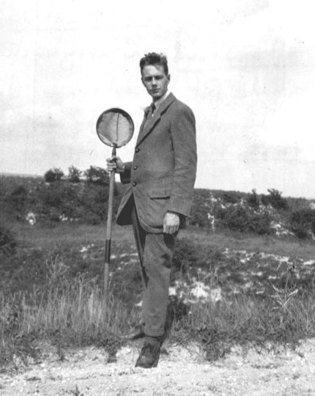 Manuscripts and ArchivesHutchinson, with his net, on an insect-collecting trip as a student at Cambridge. View full image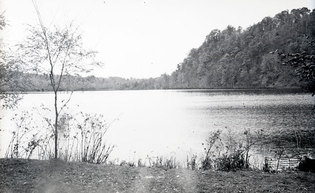 Manuscripts and ArchivesHutchinson did much of his research at Linsley Pond, a 20-minute drive from Yale. View full imageOnce Hutchinson was in New Haven, it wasn’t immediately clear that he would fit in any better than he had in Italy or South Africa. He found his new colleagues provincial and conservative, and he worried that the American system of assigned reading of textbooks deprived students of his own hunter-gatherer experience of learning by discovery. Having come from Witwatersrand, where the emerging idea of continental drift was openly debated, he also seems to have learned the hard way that even mentioning the concept at Yale resulted in “a deeply silent response comparable to what might be elicited by a grossly obscene remark at a church supper.” But the Peabody Museum “began to play a great part in my life as soon as I stepped into it,” Hutchinson later recalled. He was impressed first by the Foucault pendulum then hanging in the lobby, which made the abstract idea of the Earth’s rotation suddenly visible, and next by the theatricality of the Brontosaurus skeleton in mid-construction. But the real treasure for Hutchinson was the Peabody’s rich collection of specimens of all kinds. “One of the things that truly excited him about coming to Yale in 1928,” according to conservation biologist Tom Lovejoy ’66, a later Hutchinson student, was the Peabody display of the toothed birds Ichthyornis and Hesperornis collected by O. C. Marsh, Class of 1860—still among the most potent proofs of Darwin’s evolutionary theories. Other specimens thrilled Hutchinson on entirely untheoretical grounds. One of his most popular lectures arose from the experience of standing in the Peabody bird collection: “Suddenly it dawned on me that I had never realized what an extraordinary number of pigeons are bright green....To me, this realization, though it had no apparent value in relation to anything else I knew, gave me intense pleasure that I can still recall and reexperience. Feelings of this sort mold our lives, I think always enriching them.” Hutchinson worked closely with Peabody curators. He donated his water bug collection, as well as many of the specimens on which he based his landmark studies, to the museum. He also made frequent use of Peabody specimens in his teaching, so his students could experience the vivid feelings that come with handling specimens. His first official connection with the Peabody came in 1932, when he traveled to the Tibetan Plateau with the Yale North India Expedition. His job there, at least as the expedition geologist saw it, was to fill his collecting bottles with lots of “queer water animals.” In fact, Hutchinson was already employing his own kit of tools for characterizing not just the plant and animal life in a body of water but also the water chemistry, temperature gradients, ultraviolet light intensity, sediment composition, and paleobiology, among other parameters. He was thinking about how these physical conditions shaped the diversity of life, and about comparisons across the three continents where he had so far gathered data. Hutchinson’s approach to the natural world was unusual not just because it was so thoroughly quantitative but because it was simultaneously aesthetic and at times religious. He managed this, moreover, even under such debilitating circumstances as rowing a balky inflatable boat with low gunwales and stubby little oars across Himalayan lakes at elevations up to 17,000 feet. He described the experience of observing three tiny crustacean species in one such lake this way:
Hutchinson espoused Simone Weil’s definition of science as “the study of the beauty of the world” and regarded it as “a means of enlightenment,” according to science historian Sharon E. Kingsland. Like art, it “could produce feelings of exaltation that ennobled the human spirit.” Because this sounds so lofty, it’s worth noting that Hutchinson’s working circumstances were often in need of exaltation—or, anyway, housekeeping. According to Gordon Riley, who joined the Yale faculty after completing his doctorate with Hutchinson, “Evelyn lived in that magnificent, well-ordered mind, which was a good place for him to be, for he was surrounded by chaos. His clothes were shabby, his cars decrepit. Every surface in his office was piled high with books and papers, although he could instantly locate anything he wanted....One day he came to my lab to borrow some Nessler tubes...used in visual colorimetry. He stuck a half dozen in his jacket pocket. They went through a hole in his pocket and smashed on the floor.” 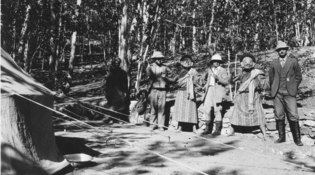 Manuscripts and ArchivesMembers of the Yale North India Expedition, including Hutchinson (far right), posed with two unnamed devil dancers in Tibet in 1934. View full image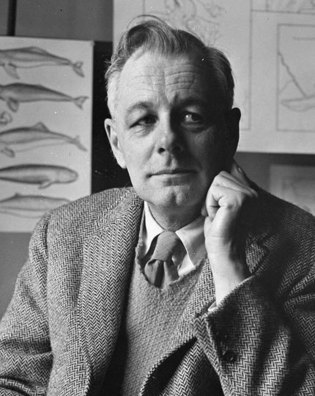 Manuscripts and ArchivesAn undated portrait of Hutchinson during his Yale years. View full imageFrom the 1930s on, Hutchinson and his graduate students conducted much of their research at Linsley Pond, a 20-minute drive from the Yale campus. It is a modest little “kettle hole” lake, formed by a huge block of ice left behind by a retreating glacier, and not otherwise particularly unusual. Hutchinson made it special. In one experiment, just after World War II, he and a student set out 24 portions of radiophosphorous on the surface of the lake, in one of the earliest successful uses of a radioactive tracer in natural history. (Student lore held that Hutchinson swam the material across the lake or, more likely, dropped a vial of the phosphorous into the bottom of the boat and then had to swamp the boat to get the phosphorous into the lake. The resulting paper merely mentions a boat.) Samples at different depths over the following week indicated that the radioactive tracer got taken up by algae and other aquatic plants, and by planktonic animals that ate these phytoplankton. Then it rained down to the bottom in their droppings and was soon released back into the water, to be taken up again by other plankton. This “biogeochemical cycling” helped demonstrate the intimate connection between the physical habitat and the species living within it. The detailed study of Linsley Pond by Hutchinson and his student collaborators would eventually produce some of the most important findings in the rise of modern ecology. Hutchinson’s science gradually developed into a definitive four-volume Treatise on Limnology. (His better instincts had initially inclined him to name it “The Natural History of Lakes.”) He also published a series of articles that would shape all subsequent ecological research. In a 1948 paper, “Circular Causal Systems in Ecology,” he asserted the power of the endless feedback loop from the inorganic to the living world and back again. (If that unified view of the world as a living system sounds familiar, it may be because many of Hutchinson’s ideas would later turn up in popularized form as part of the James Lovelock–Lynn Margulis “Gaia Hypothesis.”) Next, Hutchinson took on the idea of the biological niche, which had become an essential concept for understanding how a species fit into its habitat but was also vague to the point of being meaningless. In a 1957 paper with the underwhelming title “Concluding Remarks” (from the circumstances of its delivery), Hutchinson proposed a way to quantify all the physical and biological conditions that make up the fundamental niche of a species. Traditionalists disliked this quantitative and theoretical approach at first. They worried that biologists would come to characterize a habitat or a niche by compiling a lot of biogeochemical data without ever having laid eyes on the thing itself. Perhaps to assuage them, Hutchinson chose what was for him, at least, a highly improbable analogy. He described his “logicomathematical system” as a tool for the ecologist to bring out, like “a vacuum cleaner,” when “a lot of irrelevant litter has accumulated.” In the same article, Hutchinson took on the equally vague and commonplace idea of “competitive exclusion.” It had become biological dogma that, when two species depend on the same resource in a habitat, one will inevitably drive out the other. But Hutchinson thought people were too quick to reach for competitive exclusion as an explanation. Properly describing the niche would make it practical, he argued, to distinguish the effects of changes in the niche from those of competitive exclusion. For instance, people commonly regarded the displacement of Britain’s native red squirrels by introduced gray squirrels as an example of competitive exclusion. But closer examination had demonstrated that the driving factor was a change in the niche: human persecution, to which the red squirrels were more vulnerable, had multiplied. The influence of this work “on the ecological community was transformational,” according to ecologists Melinda D. Smith and David K. Skelly. “Much of the research effort expended by ecologists during the 1960s and 1970s traced back to Hutchinson’s insights.” Hutchinson’s ecological theories were remaking natural history as a true science. One of the most influential of his insights arose from his visit to a small pond near the hilltop church of Santa Rosalia in Palermo, Sicily. Hutchinson was puzzled to find that the pond contained a large number of water bugs—all of which belonged to just two species of the genus Corixa. The 1959 paper “Homage to Santa Rosalia” asked why this was so—and, more broadly, why there are so many kinds of animals in the world. Hutchinson saw that one Corixa species was about twice the size of the other, and also that its breeding season was ending just as that of the other species was getting under way. This led him to propose that seasonality, differences in size, and the effect of size on the resources that different species could target all played a role in shaping the diversity of species in a habitat. 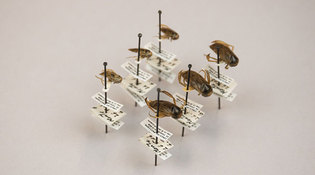 Mark Zurolo ’01MFAMany of Hutchinson’s collections are held at the Yale Peabody Museum. He collected these samples of two Corixa species (shown larger than actual size) in Sicily in 1958. They were the inspiration for his celebrated 1959 paper, “Homage to Santa Rosalia.” View full imageDespite the accolades this body of work brought to Hutchinson—Stephen Jay Gould, for instance, called him “the world’s greatest ecologist”—he regarded himself first and last as a teacher, like his father. On receiving one of the many honors and awards that came to him in late life, he dismissed the idea that he was the father of ecology, attributing that title to Charles Darwin. “I will, however, proudly admit,” he added, “to being the intellectual father of a great number of ecologists, for an extraordinary succession of incomparable young men and women who have studied with me, and I with them.” Among them was Raymond Lindeman, whose 1942 paper “The Trophic-Dynamic Aspect of Ecology” was roundly rejected at first by peer reviewers for the journal Ecology. The reviewers were shocked by Lindeman’s readiness to generalize based on a detailed study of a single lake. They objected, for instance, to his assertion that food chains are short because of what’s become known as the “ten percent law”: only about ten percent of the energy available to plants gets transferred up to the herbivores feeding on those plants, and only ten percent of that gets transferred up to the predators feeding on the herbivores. The reviewers stood fast even after Hutchinson mounted a spirited defense of Lindeman’s work. It was a classic case of radical new ideas running up against “firm resistance from the scientific establishment,” according to British ecologist Martin Kent, “yet the work was saved by the willingness of a young editor to overrule the recommendations of journal referees many years his senior.” Lindeman died of a rare liver disorder at the age of 27, before the article appeared in print but after it had been accepted. His pioneering statement of the ecosystem ecology concept, together with “the associated concepts of trophic structure, energy flows, and pathways,” Kent wrote, “have assumed the status of the central paradigm of ecology and many would argue of biogeography as well.” Robert MacArthur, one of the founders of evolutionary ecology, was also among Hutchinson’s students. He introduced central concepts of population ecology and later went on to write, with E. O. Wilson, The Theory of Island Biogeography. That book’s analysis of the geographic distribution and extinction of species provided some of the fundamental thinking for the new field of conservation biology and for the science-based planning of protected areas. Hutchinson also taught many women at a time when they were generally unwelcome in science, among them such prominent names in their fields as Alison Jolly and Donna Haraway. Incredibly, given this record of success, molecular biologists at Yale in the mid-1960s began to systematically purge Hutchinson’s students—and ecology itself—from the faculty. They considered this line of research mere natural history, the stuff of Victorian bird egg and butterfly collectors, and utterly obsolete in the DNA era. The study of the organisms and ecosystems of the living world would not recover until the university belatedly established a department of ecology and evolutionary biology in 1997, six years after Hutchinson’s death. By then, though, the ranks of Hutchinson’s intellectual progeny, many of whom had never met the man except through the power of his ideas, had spread well beyond Yale to include countless researchers on campuses and in conservation groups around the world. Gerardo Budowski, the first director general of the International Union for Conservation of Nature, took a single course with Hutchinson at Yale in the early 1960s. But he might have been speaking for the entire conservation and ecology community when he remarked that, even decades later, “My mind is still full of him.”
The comment period has expired.
|
|